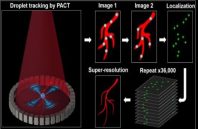Researchers at the California Institute of Technology (Caltech) Optical Imaging Laboratory (Pasadena, CA) have developed a technique for in vivo superresolution photoacoustic computed tomography (PACT) that breaks the acoustic diffraction limit by localizing the centers of single dyed droplets flowing in blood vessels. This technique has been shown to resolve brain blood vessels at a sixfold finer resolution.
Photoacoustic computed tomography (PACT) is a noninvasive hybrid imaging technique that excites biological tissues with light and detects the subsequently generated ultrasound to form images. PACT combines the advantages of both optical imaging—high optical contrast and ultrasonic imaging—high resolution and deep penetration in biological tissues. PACT has been widely used for vascular network mapping, functional brain imaging, and tumor detection in deep tissues.

 (585) 768-2513
(585) 768-2513

